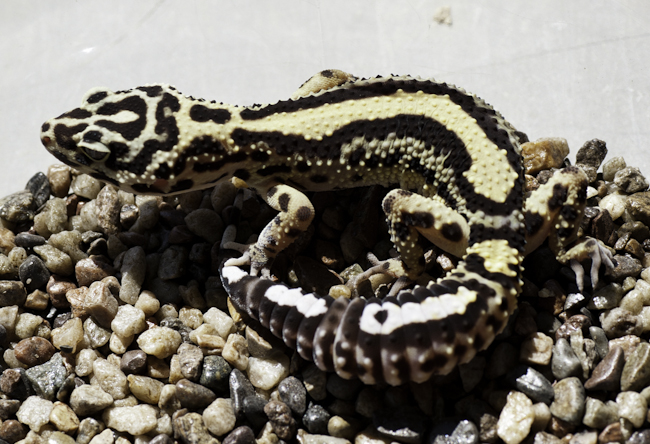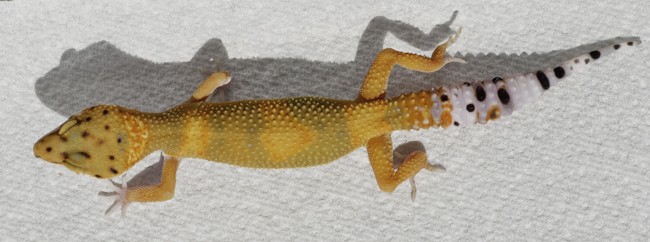Ramblings and Recollections of 2012 (so far)
I know what you are thinking. “Who does this guy think he is? Interviewing himself?” Bear with me now. It has been a rough first full year back breeding Leos. Last year was only a partial year of breeding. Things were newer, fresher and more fun. This year has been, well, tribulations and trials and . . . So it’s been tough finding topics for interviews with REAL Leopard Gecko breeders.

Incubation and Fertility
There are, however, 32 juvenile and newly hatched Geks in the racks. I hatched 37 (the other five were either culled for developmental issues or sold to local folks) up to this point while battling moisture problems in my Geo cups and fertility problems in my breeding groups. The moisture problems have cleared up by using less water in the Geos; first filling them up with the recommended Perlite and water ratio, then pouring as much of the water off as I could. Of course, I read about this approach on the gecko forum. Thanks forum posters. My follow-up methodology was easy. I wiped the condensation off the lids when it became too thick. Duh! Guess the “fill ’em up, set up the eggs, and forget about ’em” approach was NOT one to follow with my incubator in my Gek room. Might work for you; didn’t work for me.
Fertility ramped up to better hatch ratios when I changed my vitamins. I used Vionate, which is not as easy to powder live food items with as the finely ground vitamins. It is a bit coarser, but the Geks seemed to partake of that from their vitamin cups a tad bit more than usual. Of course, I am just now seeing the improvement, in time for me to close down the breeding operations here for the year. The eggs already in the incubator are the last ones I will set. I have only one female still in production (only six left in the breeding racks), and if her eggs have good size I might add them to the incubator. The two she laid in the water cup were thrown out this morning.

Results
Although it has not gone as I anticipated (or hoped for), I am happy with several of the young Geks in my shoebox tubs. The babies from my W & Y Bell Albino male from TUG have been problematic. They are tough to discern-“is they or isn’t they” W & Ys. The lightest hypo-ish Normal TSM looks to have higher than normal white on his sides, so he might be a W & Y. The Bell Albino TSFe from the TUG male is brighter than the average Bell Albino, so she, too, might be a W & Y. I’m saving judgment on a few of the other normals until I see them grow to adult size. I can say without reservation that, when I get my JMG W & Y female into the breeding scheme next year, I should NOT have this problem. She looks the part. I can “see” her W & Y characteristics quite clearly. Yes, I’ve read the posts on the Gecko Forum about “how to” identify the W & Y. It seems that Bell Albino W & Ys just look a bit different than the other W & Ys, or at
least mine certainly does.
There are several wonderful Bold Striped juvies in the racks bred from my OG breeders from Eric, along with a smattering of nice Tangerines from my Electric Tangerine male from Kelli and the Hypo Tang and Blood males from JMG. None will be the “call home” Tangs I wanted, but few ever are. I’ll await their transformation as they mature. I did hatch a few from the Blood male and a Bold Stripe female. That was one mating I REALLY wanted to work. Looks like it did. I was simply attempting to add more bold markings to Bloods with spotted heads. A couple of TUG snows from a very green Hypo TUG Snow male (now living with my grandson who got me started in this endeavor last year) and a lovely Hypo Lavender Bell Albino female from Pac Herp look like “crackers.”
Now all I need to do is to let them mature and develop before sorting them out. I’ll bet that won’t be as easy as it seems.



He is really big! He just teurnd a year old and my new females around 9 months old. They are all spoiled so he got big fast wonder what the babies will be like?